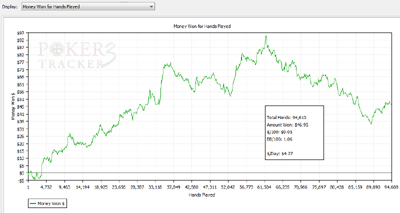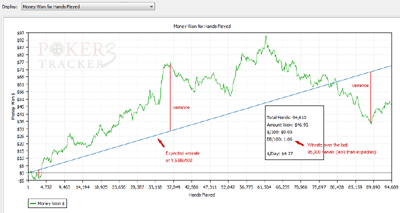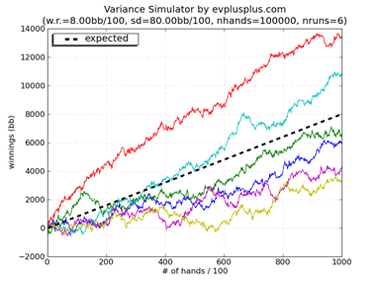Poker Variance

In this article I am going to talk about the basics of variance in poker and how it affects your game.
There can be a lot of mathematics involved with variance. However, this is largely going to be a non-mathsy article about variance, which I’m sure will be very welcomed by a large number of you reading this.
What is variance?
Variance is the downswings and upswings involved with playing poker.
It’s quite possibly the least technical definition for a term I have ever written, but the “ups and downs” of poker when it comes to winning and losing money sums it up rather well.
Variance is the difference between how much money you expect to win on average over the long run and the results you are seeing in the short term. So for example, if according to your win rate you expect to win $500 in a month on average but end up losing $1,000 instead, this is attributed to variance.
Examples of variance in poker.
Going all-in with pocket aces.
Let’s say that you are playing heads up against a total maniac that moves all-in on every hand. Furthermore, by a pure stroke of luck and through the magic of me being able to make examples up, you are dealt pocket aces 5 times in a row. Obviously, you decide to call all-in 5 times before the flop too.

Equity of aces against a random hand from Pokerstove.
Against any random hand, AA has an 85% chance of winning. Therefore we expect to win roughly 4 out of these 5 all-ins, although we would ideally like to win them all.
However, you actually end up losing all 5 all-ins against your opponent’s 5 random hands. It was amazingly unlikely (0.007% unlikely), but the fact is that it is possible (1 in 1,410,192 possible) and it did happen.
On average you expected to win 4 out of these 5 all-ins, but thanks to variance you ended up winning 0 out of 5. As you can see, variance is the difference between the expected long term results and actual short term results, in this case it is 4 buy-ins worth of variance.
Variance in graphs.

As you can see from this graph the rate at which this player wins money is far from linear. Sure, his stats may show a winrate of 1.06 BB/100, but there are times where he loses more than he expects and wins more than he expects.
Variance compared to an expected winrate.
However, now let’s say that this player had a winrate of 1.5 BB/100 (3 bb/100) over his last 1 million hands prior to this current time period. If we plot this expected winrate on the graph, we get to see how much variance is taking place compared to what this player expects to be winning in a perfect world.

Over a long enough period of time his actual results will meet up with his expected results, but in the short term the amount that he wins or loses in the hands of our good friend variance.
For more information on stuff like BB/100 and bb/100, see the article on win rates in poker.
What causes variance?
The element of luck causes variance.
As we know there is an element of skill involved in poker, but there is also a lot of luck. We have no control over the hands that we are dealt or the cards that are dealt on the board, so this uncertainty or “luck” is the cause of variance over the short term.
We all have to deal with it and it’s to be expected, so get used to it. Regardless of how good you are, those 5, 10 and even 20+ buy in downswings will hit us at various points in our poker careers.
What influences variance?
There are a few factors that can increase or decrease the amount of variance that you encounter:
- Your playing style. If you play a very loose-aggressive style of play then you will be involved in a lot more pots and will be consequently risking more money than your average tight player. The looser you are and the more risks you take, the greater your variance will be.
- The poker game. Omaha has less variance than Hold’em because the hands in Omaha generally have less of an edge against one another when players move all-in (odds of each hand winning are closer to 60/40 as opposed to something like 75/25). Therefore the smaller the edges, the less the variance.
- The betting type. No limit has greater variance than limit poker, where the amount of money that players can put in to the pot is much smaller in relation to the blinds in limit games than it is in no limit games. The more money you can risk, the greater the variance.
- The game type. Large MTTs will have much more variance than SNGs because you expect to win far less often. However, when you do win an MTT you receive sudden large payouts, which obviously results in higher levels of variance.
There are definitely a lot more factors that can affect the variance that you come up against in your poker career, but these are the most obvious ones and the ones that will have the greatest influence on the size of your “ups and downs”.
Top Tip: Add some extra variance to your bankroll by playing poker with bitcoin.
Anticipate your swings with a variance simulator.
To get a really good idea of how much your winnings can vary over a set number of hands, try using this poker variance simulator.
Just enter your winrate and standard deviation (which can be found in PokerTracker or Holdem Manager) and see how differently the outcomes can be.

You may be surprised at the size of the possible swings and just how different your results can be over large sample sizes. It's a real eye opener if you think your recent 5 buy-in downswing was bad.
More information on standard deviation and variance can be found in the Holdem Manager guide video starting at 6:16. It also gives you a quick example of how to use the ev++ variance simulator.
How variance affects the game.
- It makes it hard to tell if you’re playing well or not.
- Variance can be mentally draining for even the best players.
- On a positive note, variance is the reason why the bad players keep playing.
1) Thanks to variance, you can never truly rely on your short-term results as an indication of how well you are currently playing. You might be playing out-of-your-skin poker but still lose money, which makes it frustratingly difficult to analyse what you might be doing right and what you might be doing wrong.
You have to trust that you are making good plays and feel genuinely comfortable about how you are playing, regardless of what current results attempt to indicate. Confidence in your ability at the poker table is a very important quality to posses during a downswing. You just have to keep learning and trust that it’s paying off.
2) The fact that you can lose money even when you are playing well is horrible. However, you have to get used to it if you want to win money from poker over the long run. Playing well when you’re winning is easy; playing well when you’re losing is a different kettle of fish.
Learn to play you’re ‘A game’ at all times or variance will get the better of you. We all encounter bad doses of variance, but not all players can handle it.
3) On the other side of the coin, the fact that players (specifically bad ones) can win money even when they are playing terribly is actually a good thing. If these bad players never won any money, half of them would just quit playing. Be thankful that bad beats exist so that these bad players can slowly but surely hand their money to you.
Evaluation of variance in poker.
Variance happens. Sometimes it sends us on ridiculously good upswings, sometimes it sends on horrendously frustrating downswings. Either way, at the end of the day you have to accept the fact that variance plays a big part in every poker player’s game. If you expect variance to kick the shit out of you once in a while, it will be much easier for you to deal with it.
For further reading, you may find the articles on expected value and Sklansky bucks interesting too.
Go back to the awesome Texas Hold'em Strategy.
Comments

